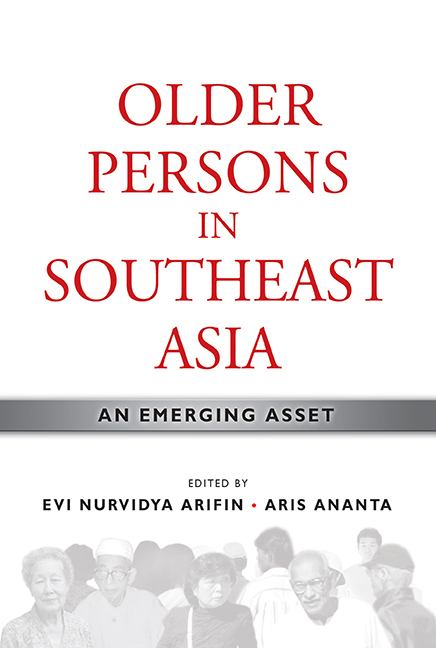Book contents
- Frontmatter
- Contents
- List of Tables
- List of Figures
- Foreword by Hal Hill
- Message from the Director
- Preface
- Contributors
- PART I INTRODUCTION
- PART II OLD-AGE INCOME SECURITY
- 3 Economics and Old Age: The Singapore Experience
- 4 National Long-Term-Care Severe Disability Insurance in Singapore
- 5 Social Security and Health Care Financing for Older Persons in Thailand: New Challenges
- 6 An Exploration of a Universal Non-contributory Pension Scheme in Vietnam
- PART III EMPLOYMENT AND OTHER SOURCES OF FINANCIAL CONTRIBUTION
- PART IV AGEING, MIGRATION, AND DEVELOPMENT
- PART V ROLES OF GOVERNMENT AND CIVIL SOCIETY
- Index
3 - Economics and Old Age: The Singapore Experience
from PART II - OLD-AGE INCOME SECURITY
Published online by Cambridge University Press: 21 October 2015
- Frontmatter
- Contents
- List of Tables
- List of Figures
- Foreword by Hal Hill
- Message from the Director
- Preface
- Contributors
- PART I INTRODUCTION
- PART II OLD-AGE INCOME SECURITY
- 3 Economics and Old Age: The Singapore Experience
- 4 National Long-Term-Care Severe Disability Insurance in Singapore
- 5 Social Security and Health Care Financing for Older Persons in Thailand: New Challenges
- 6 An Exploration of a Universal Non-contributory Pension Scheme in Vietnam
- PART III EMPLOYMENT AND OTHER SOURCES OF FINANCIAL CONTRIBUTION
- PART IV AGEING, MIGRATION, AND DEVELOPMENT
- PART V ROLES OF GOVERNMENT AND CIVIL SOCIETY
- Index
Summary
The indicators in Singapore are good. The infant mortality rate was 2.6 per 1,000 live births in 2007. It had been 8.0 in 1980, and 82.0 in 1950. In the United States the rate was 7.0, in Sweden and Japan 3.0, in China 23.0, and in India 62.0. Life expectancy at birth was 77.9 for males, 81.8 for females: the average was 15 years longer than at internal self-government in 1959. The corresponding figures were 75.0 and 80.0 in the United States, 78.5 and 85.5 in Japan, 66.0 and 70.0 in Indonesia, 61.0 and 63.0 in Laos. Figures 3.1 and 3.2 show where Singapore stands.
Healthy life expectancy at birth was 68.8 for males, 71.3 for females in 2007. In the United States, the respective figures were 67.2 and 71.3, in Japan 72.3 and 77.7. Adult mortality in the productive years of 15-60 was 85 per 1000 for males, 50 for females: in United States the figures were 144 and 83, in Sweden 82 and 51 (World Bank 2007). Figures 3.3 and 3.4 illustrate Singapore' relative performance.
The World Health Organization (WHO) ranked the effectiveness of Singapore' health care system sixth among its 191 member states: France was first, Japan tenth, the United Kingdom eighteenth, the United States thirty seventh. Fairness of financing was a different matter. There Singapore was number 101 (World Health Organization 2000: 154). Colombia topped the list for fairness.
There were 2.9 hospital beds per 1,000 of population in Singapore (fewer than the 3.3 in United States, or 4.0 in the United Kingdom, far fewer than 7.6 in France or 14.3 in Japan). There were 1.3 doctors per 1,000 of the population. In Japan the figure was 1.98. In the United States it was 2.2, in the United Kingdom 2.3, in France 3.4 (World Health Organization 2006; World Bank 2007). Figures 3.5 and 3.6 using data from 2005 and 2006 indicate Singapore' position in a representative subset of countries.
As is so often the case in health policy, outcomes are not proportional to inputs. Even so, the supply of professionals, tightly capped in the past, is being allowed to expand. There is now a second local medical school: as well as the (undergraduate) School of Medicine at the National University of Singapore, there is the Graduate Medical School jointly run by the National University of Singapore and Duke University.
- Type
- Chapter
- Information
- Older Persons in Southeast AsiaAn Emerging Asset, pp. 71 - 96Publisher: ISEAS–Yusof Ishak InstitutePrint publication year: 2009

